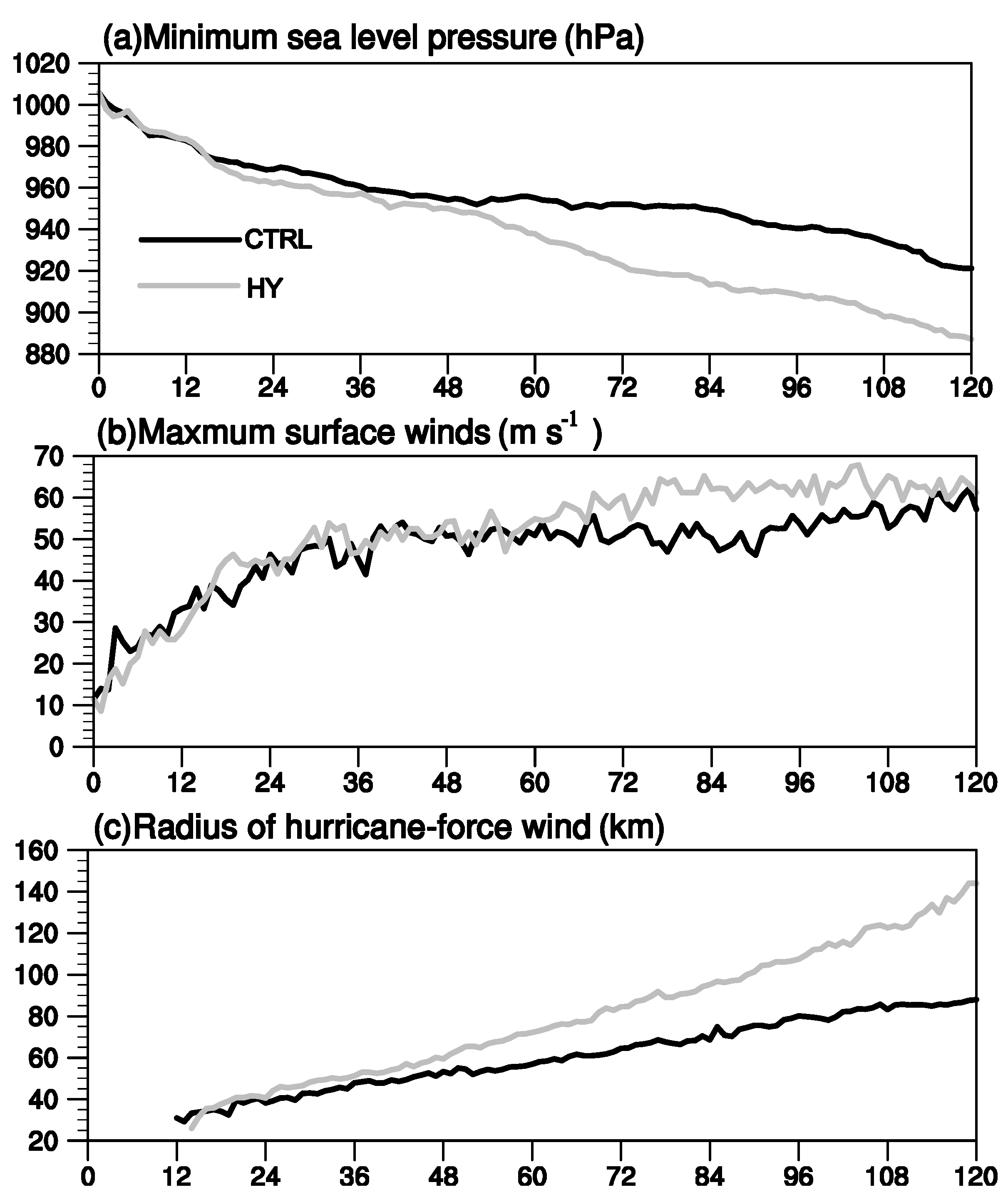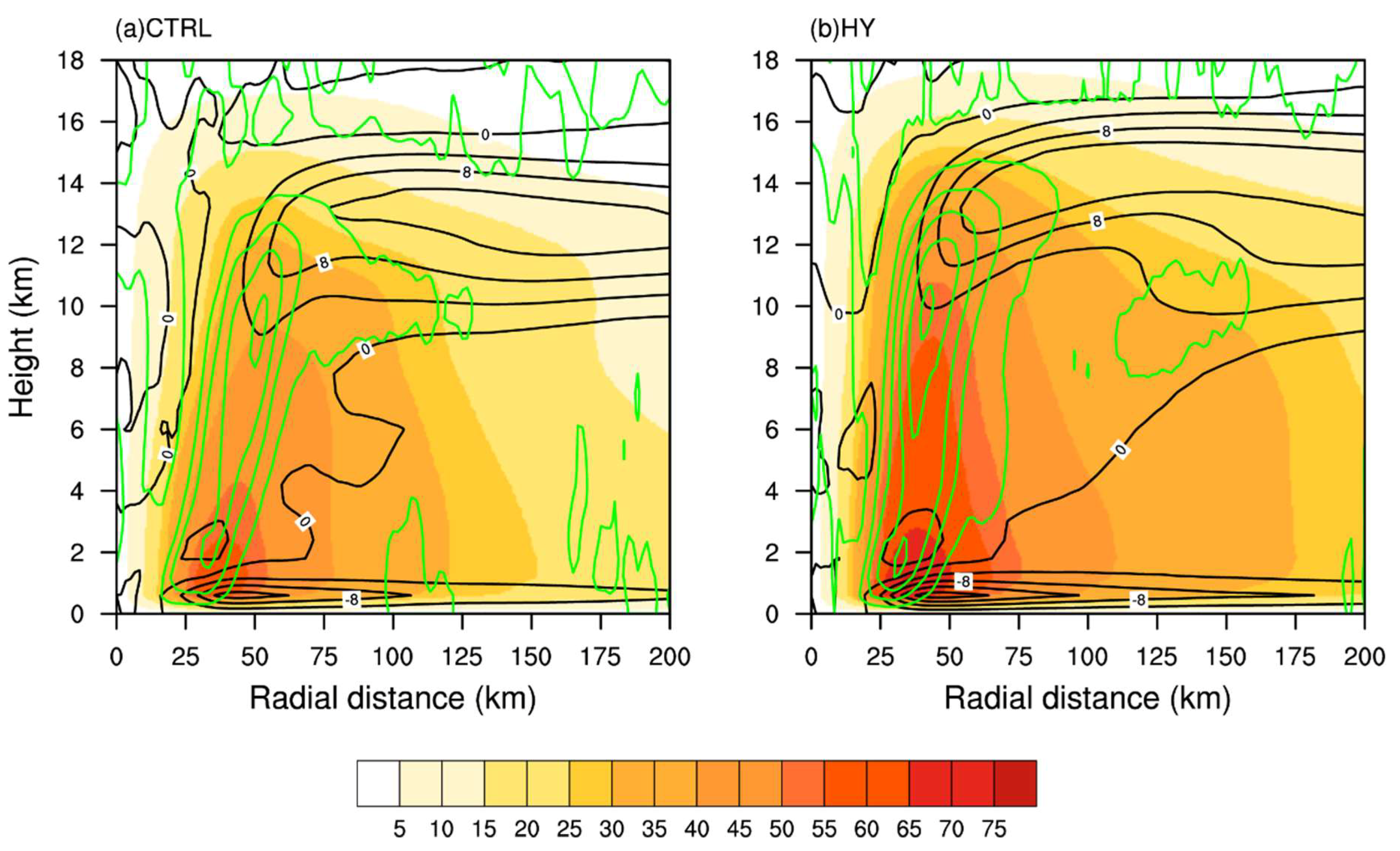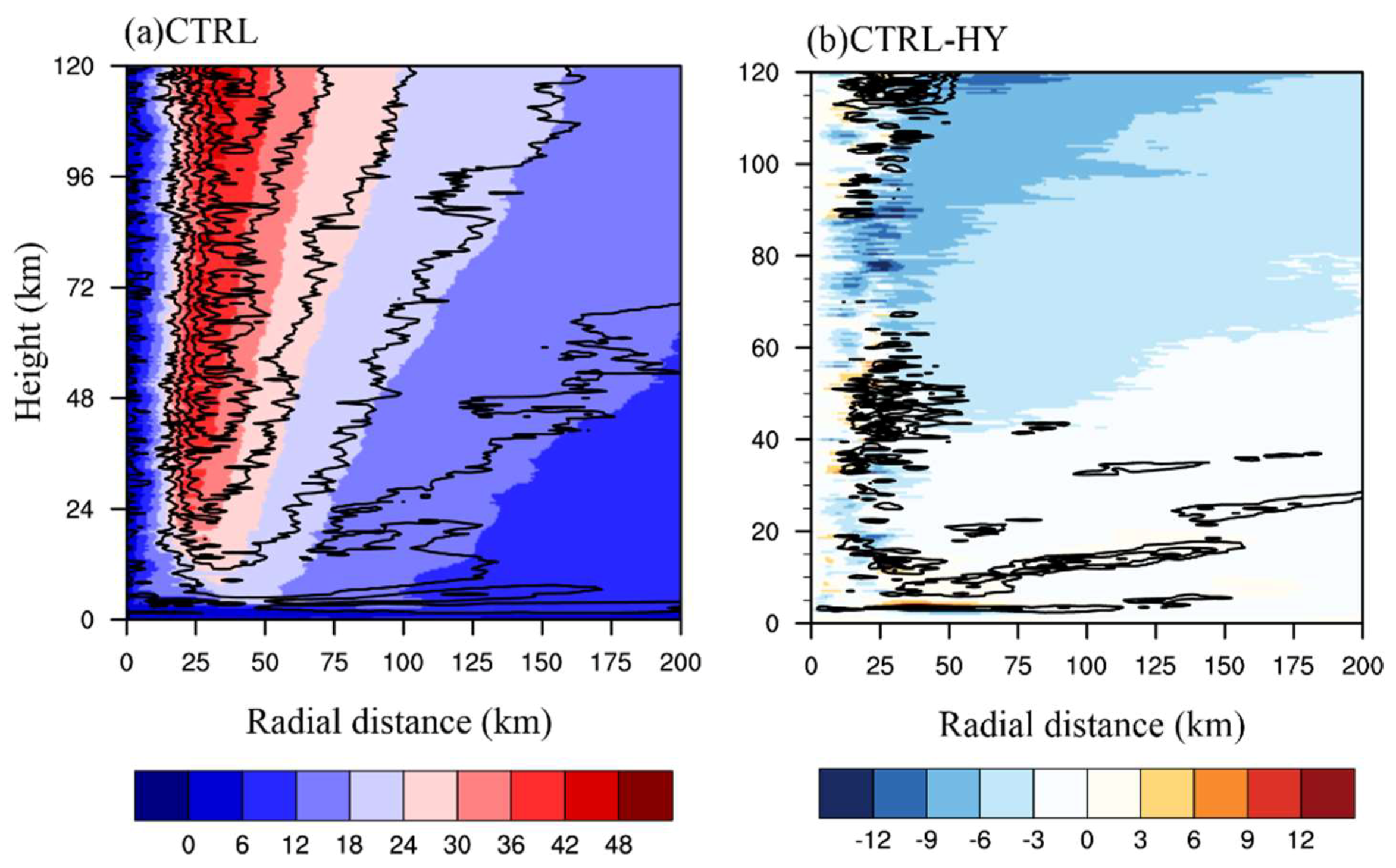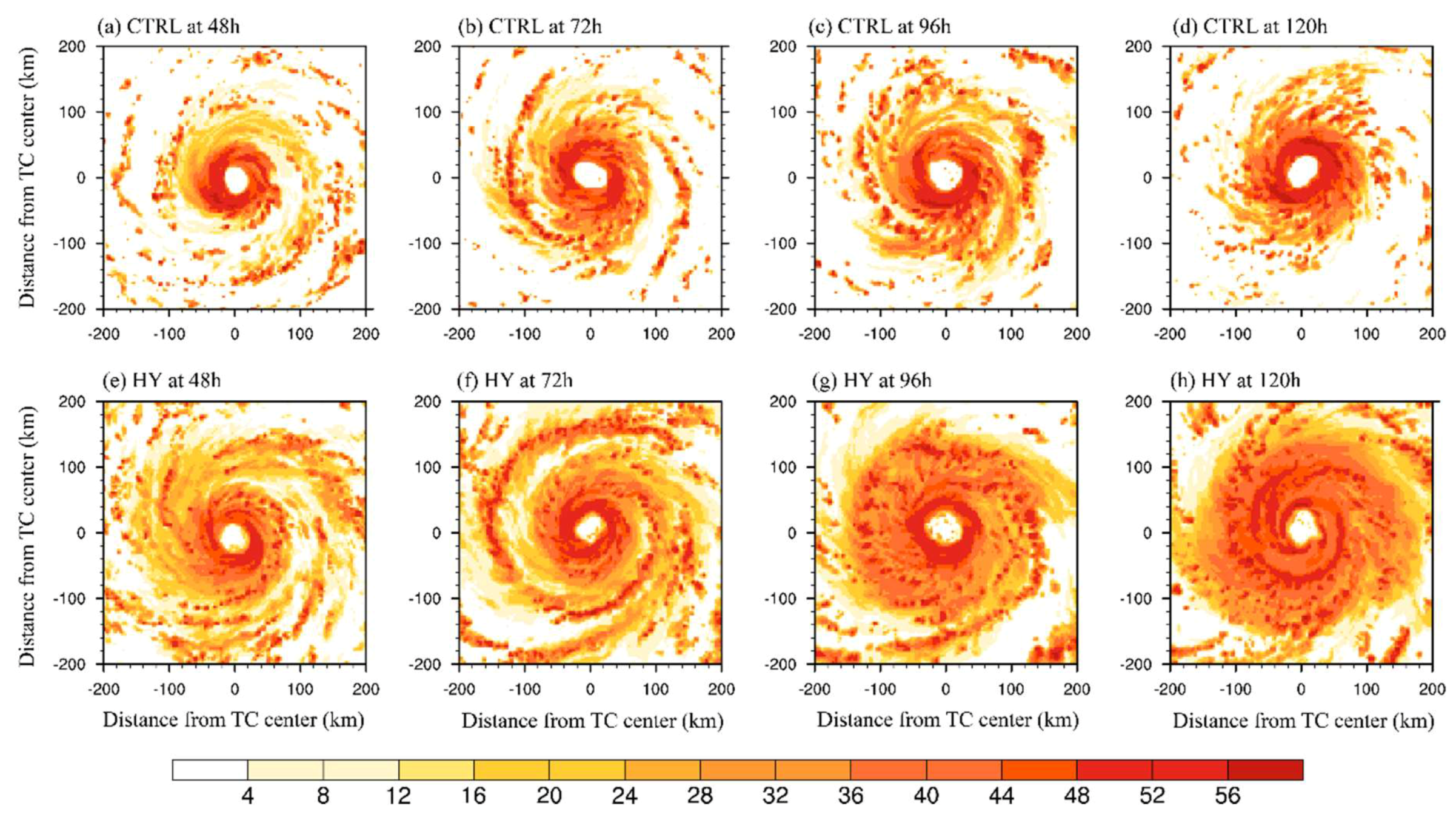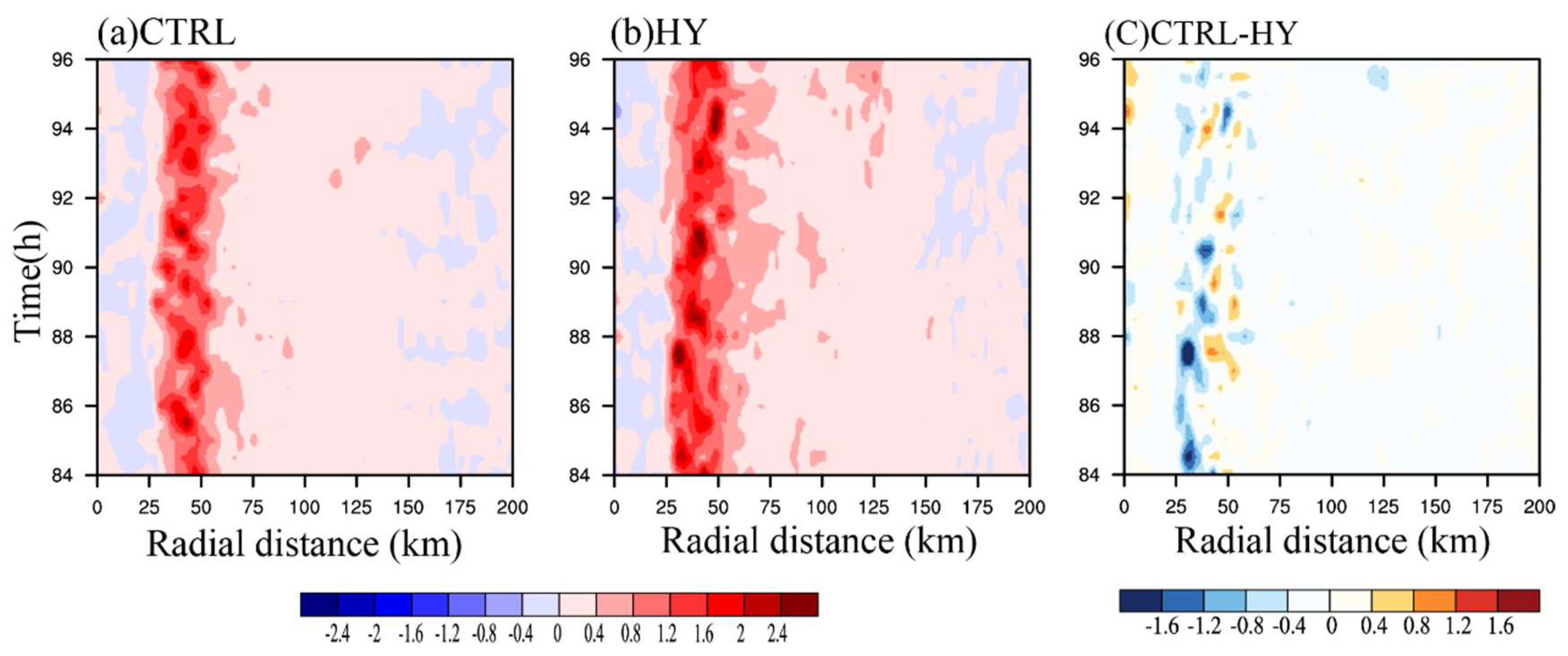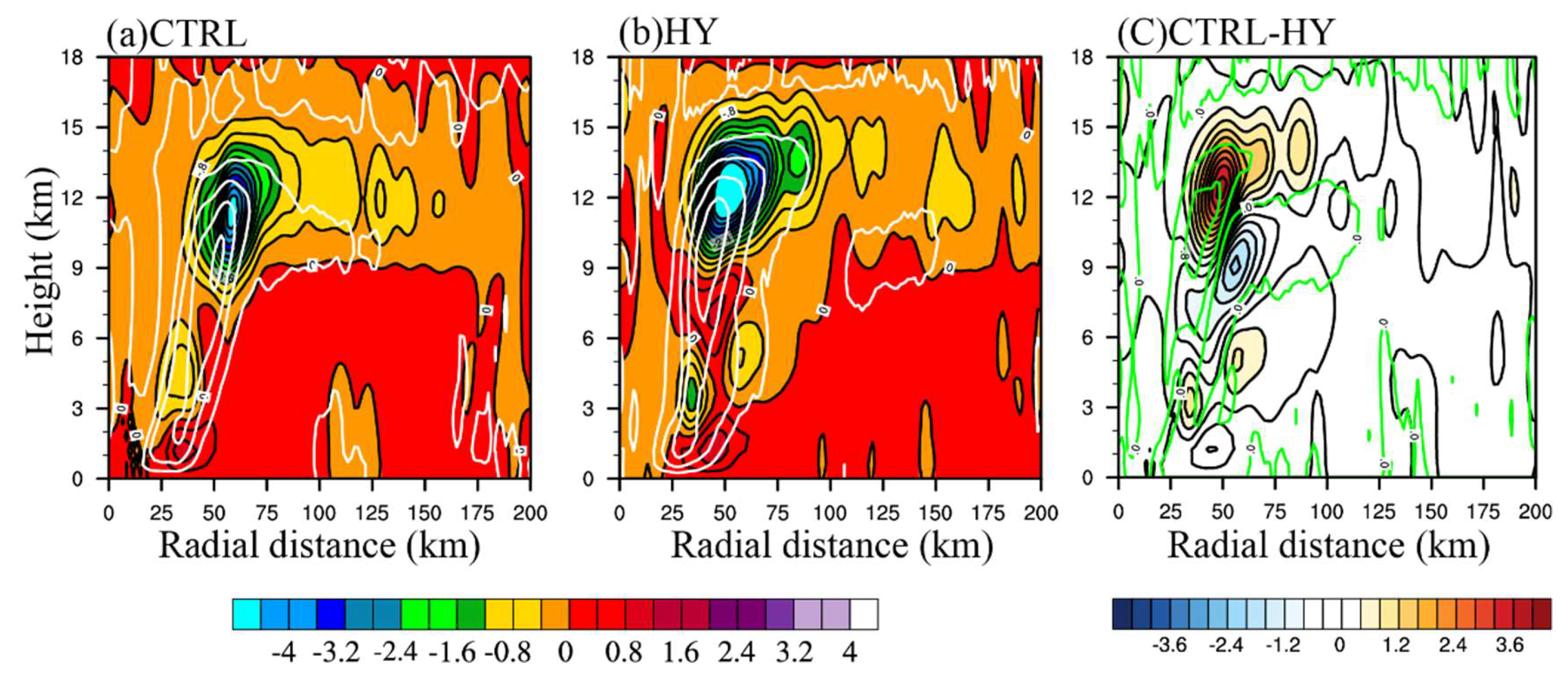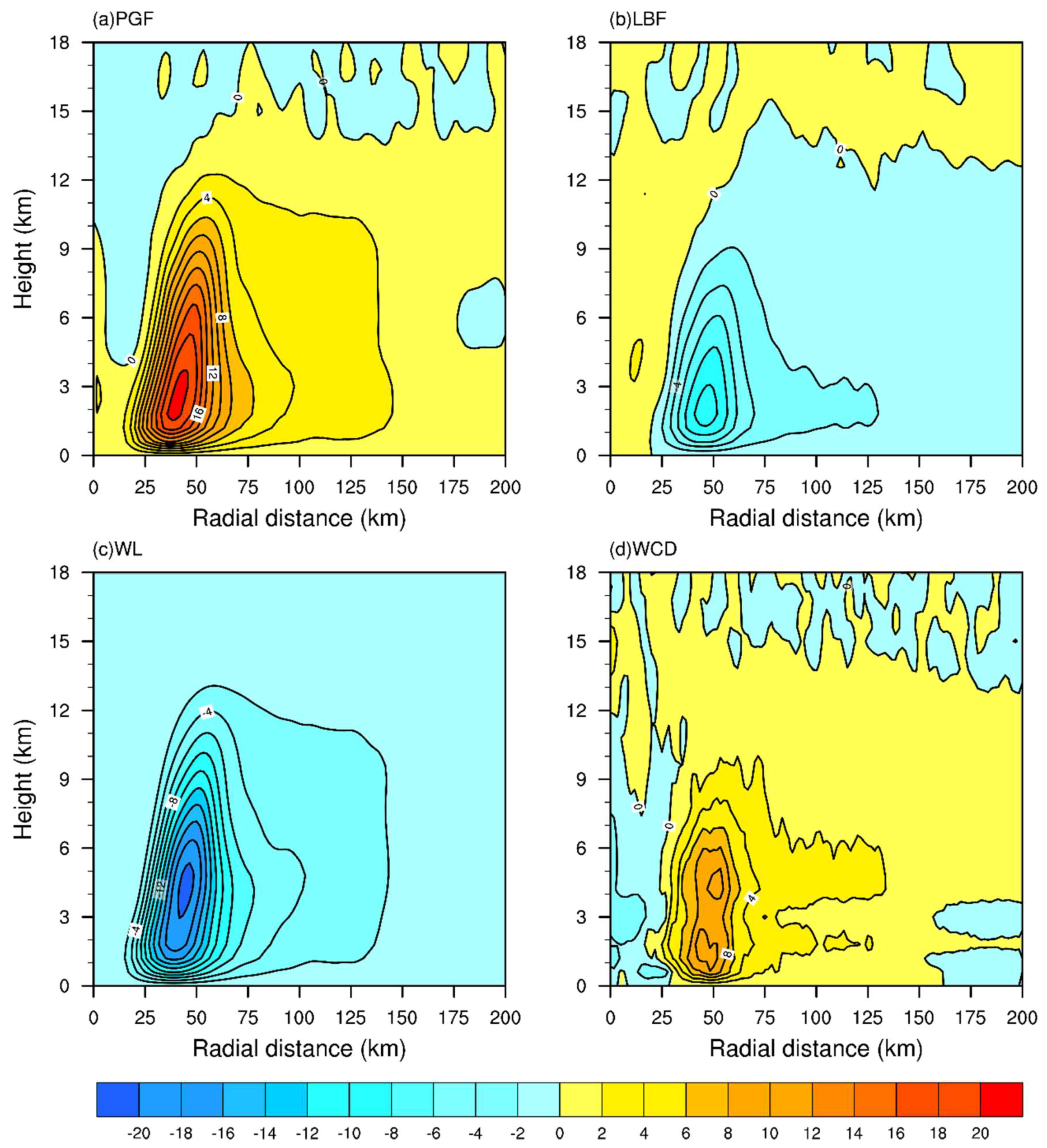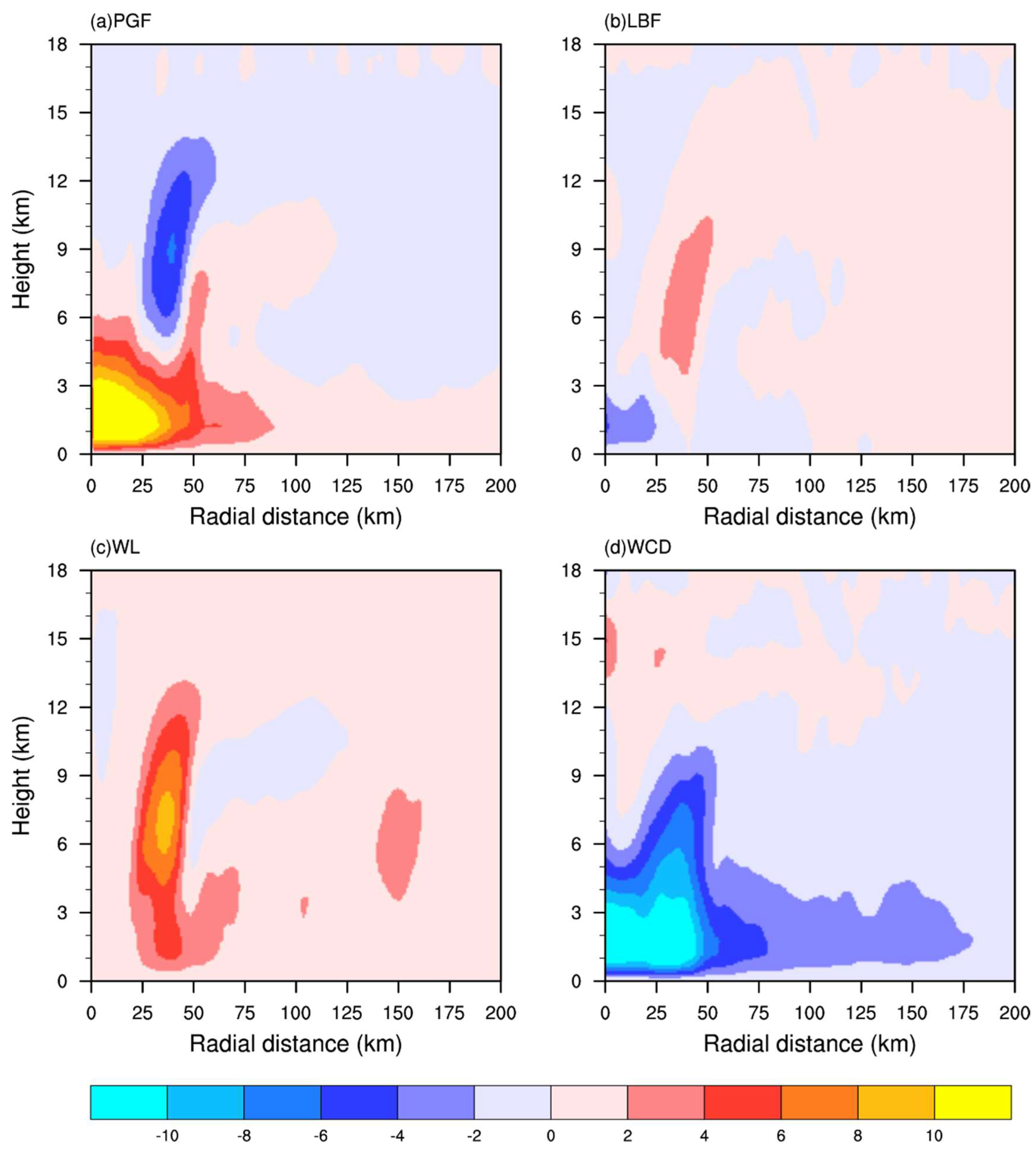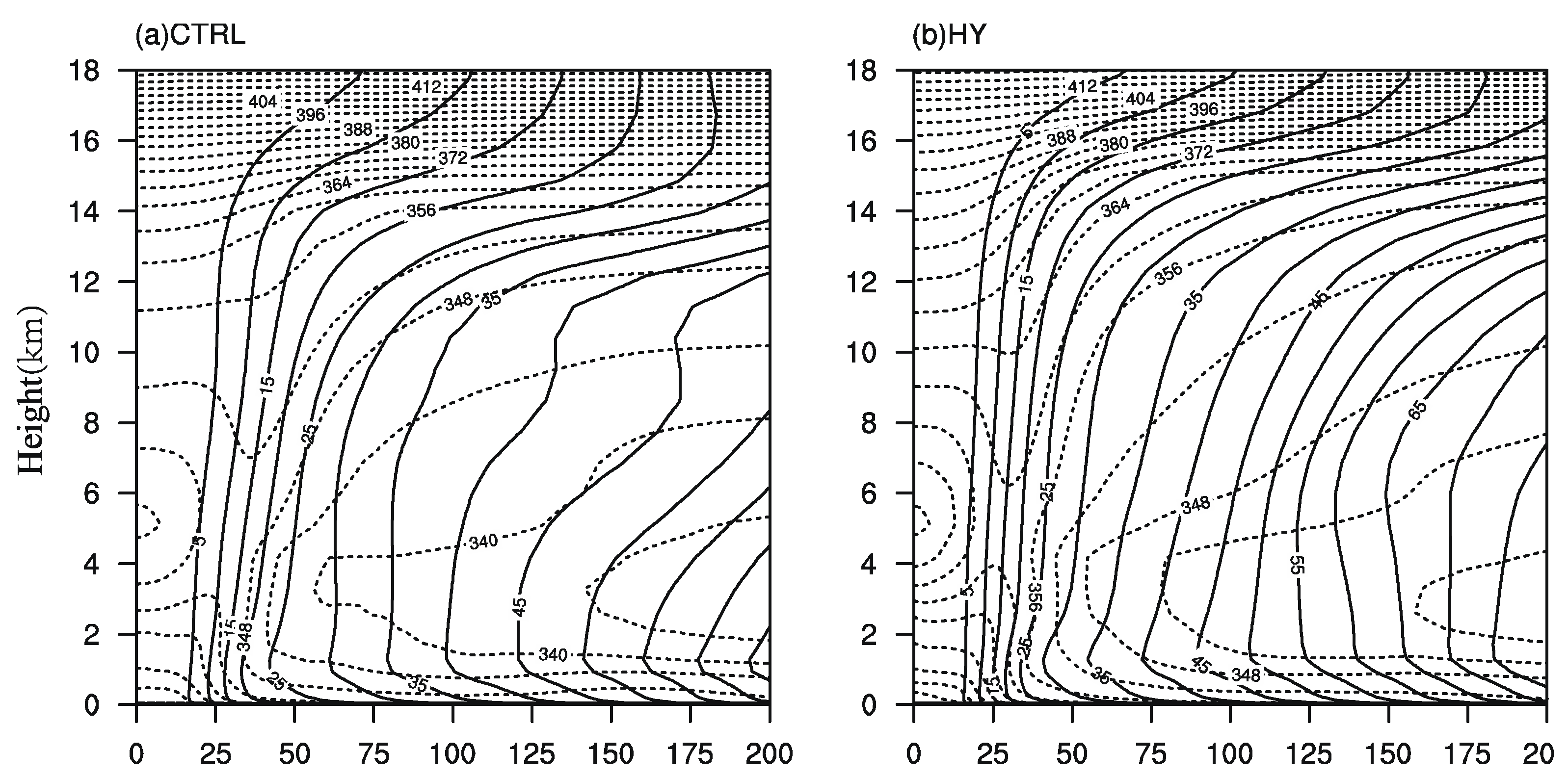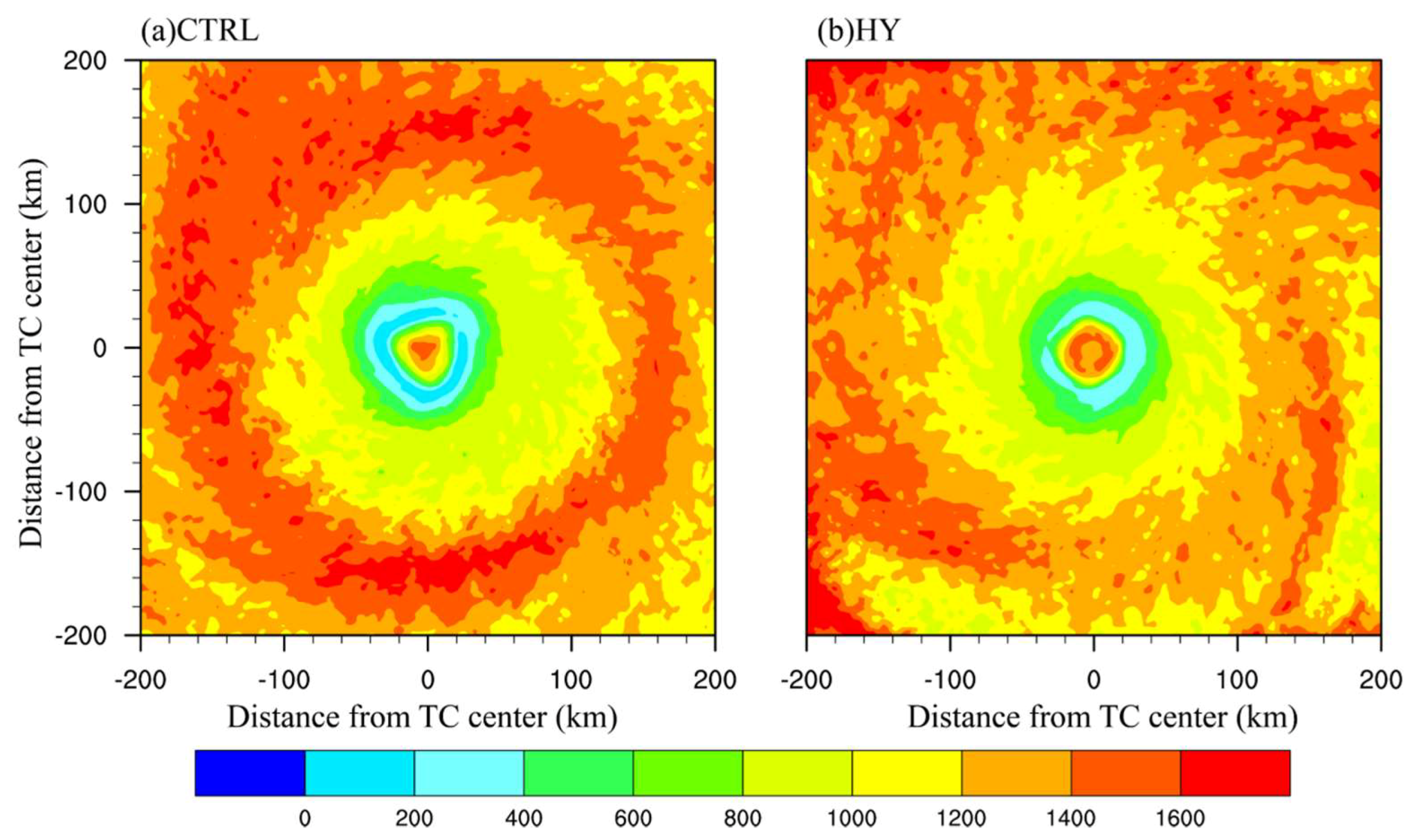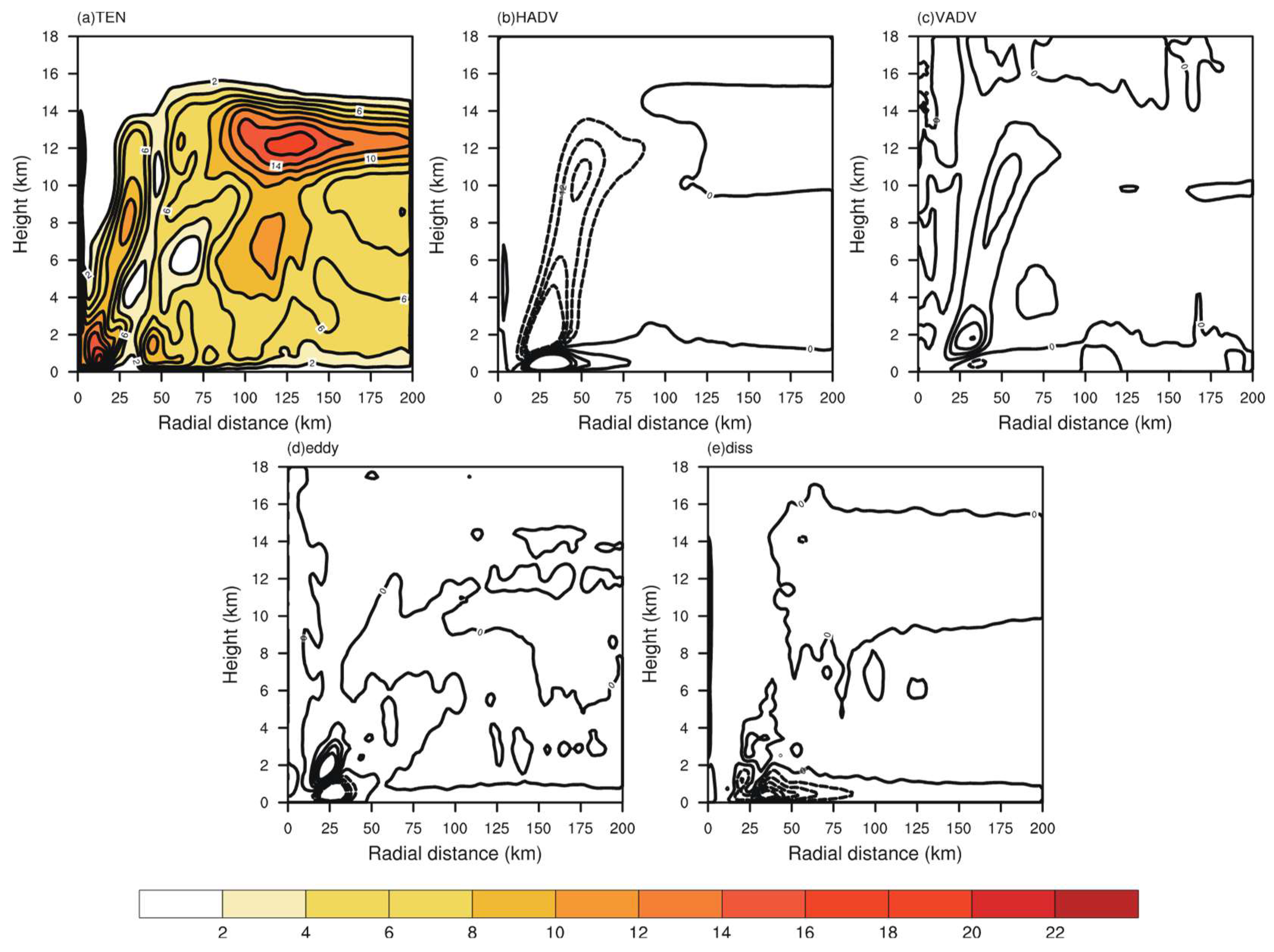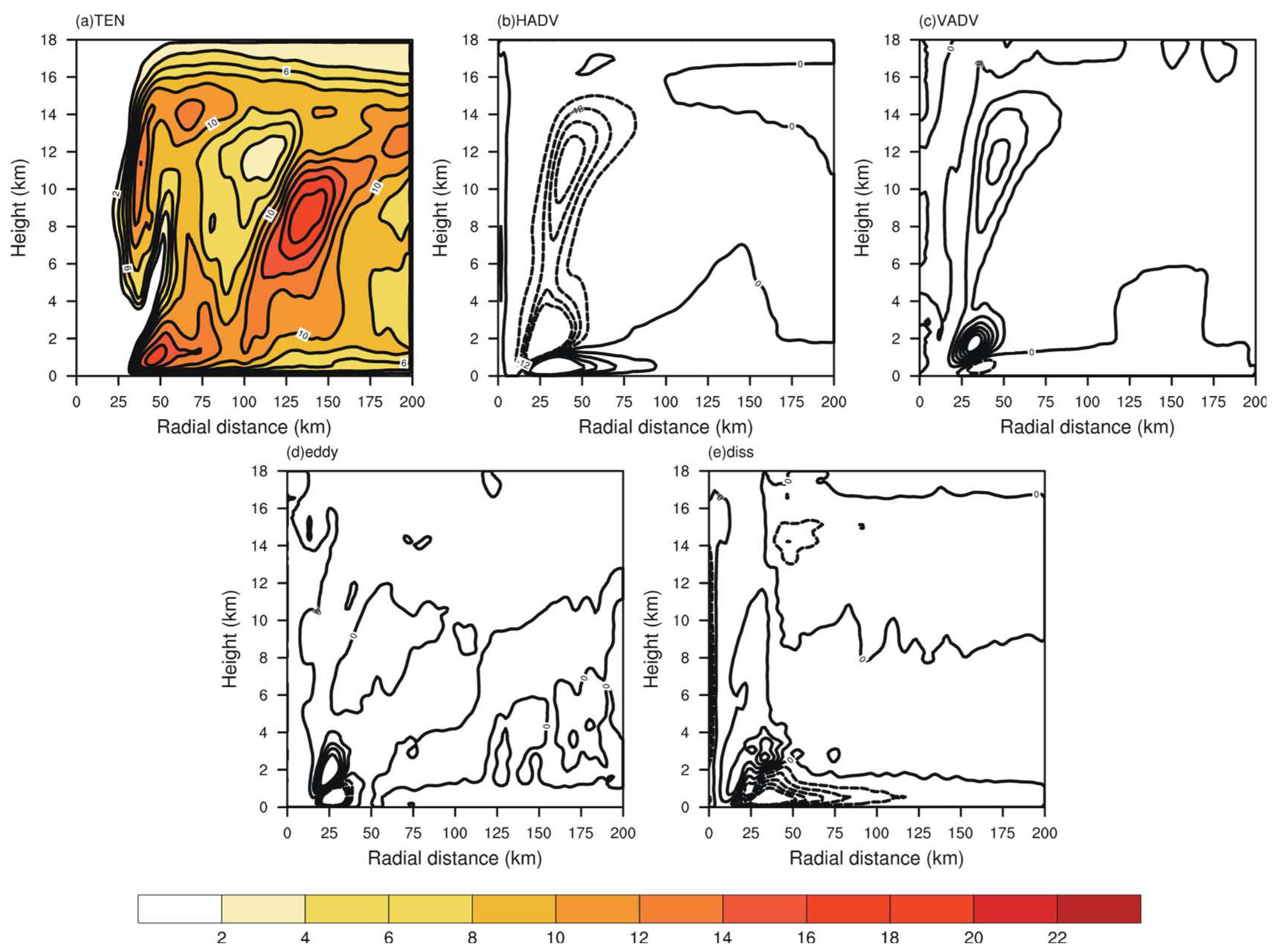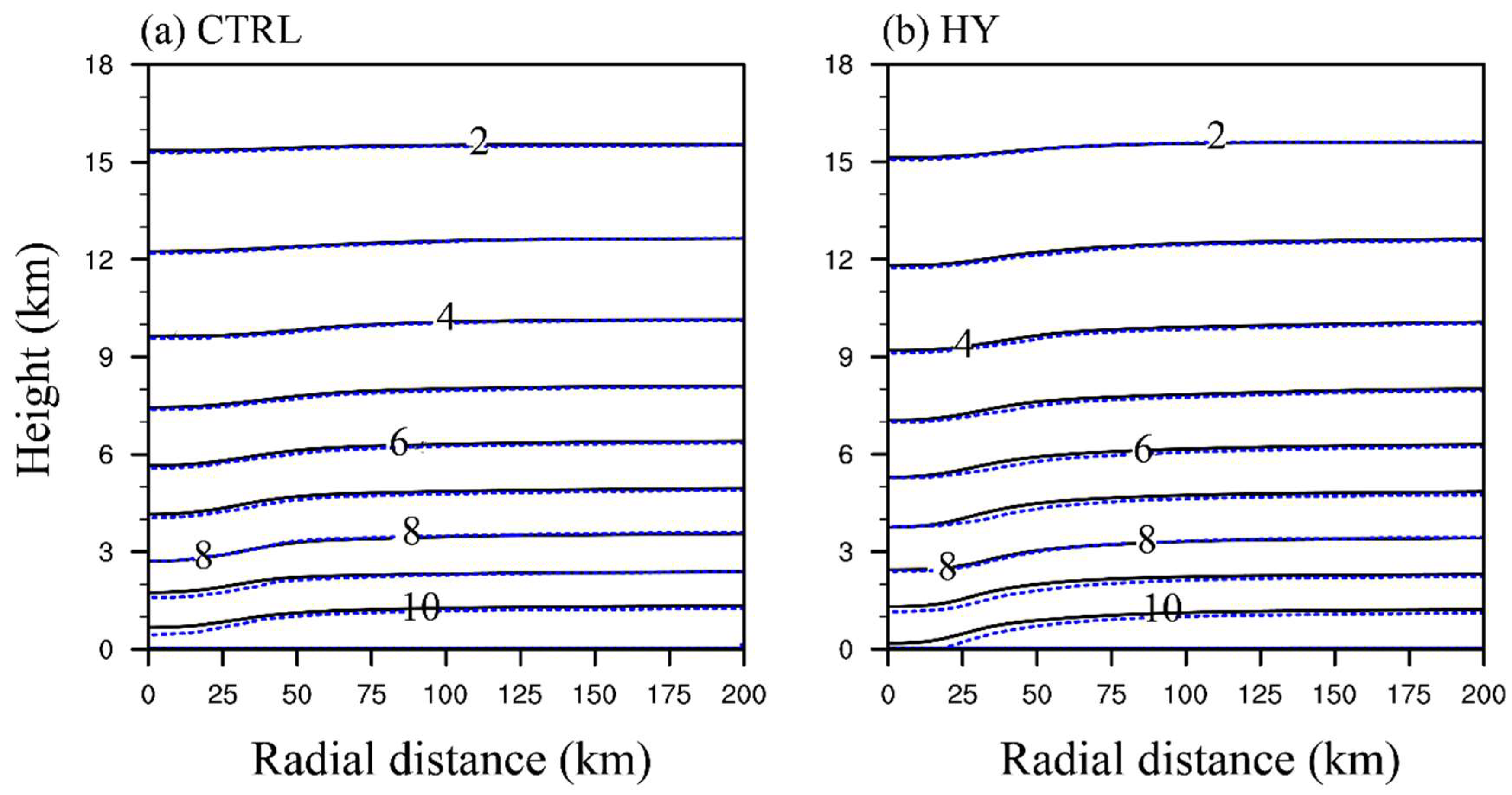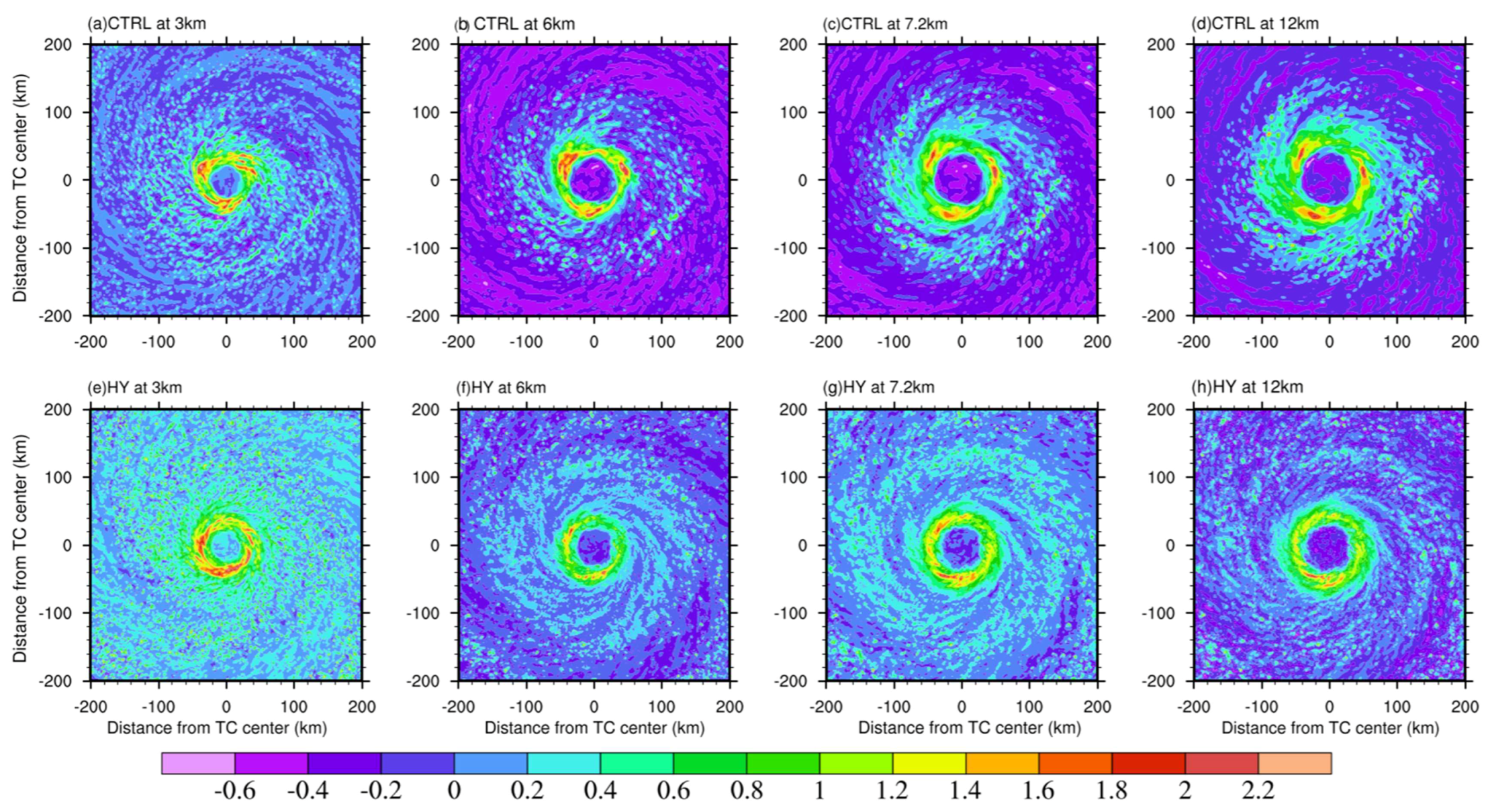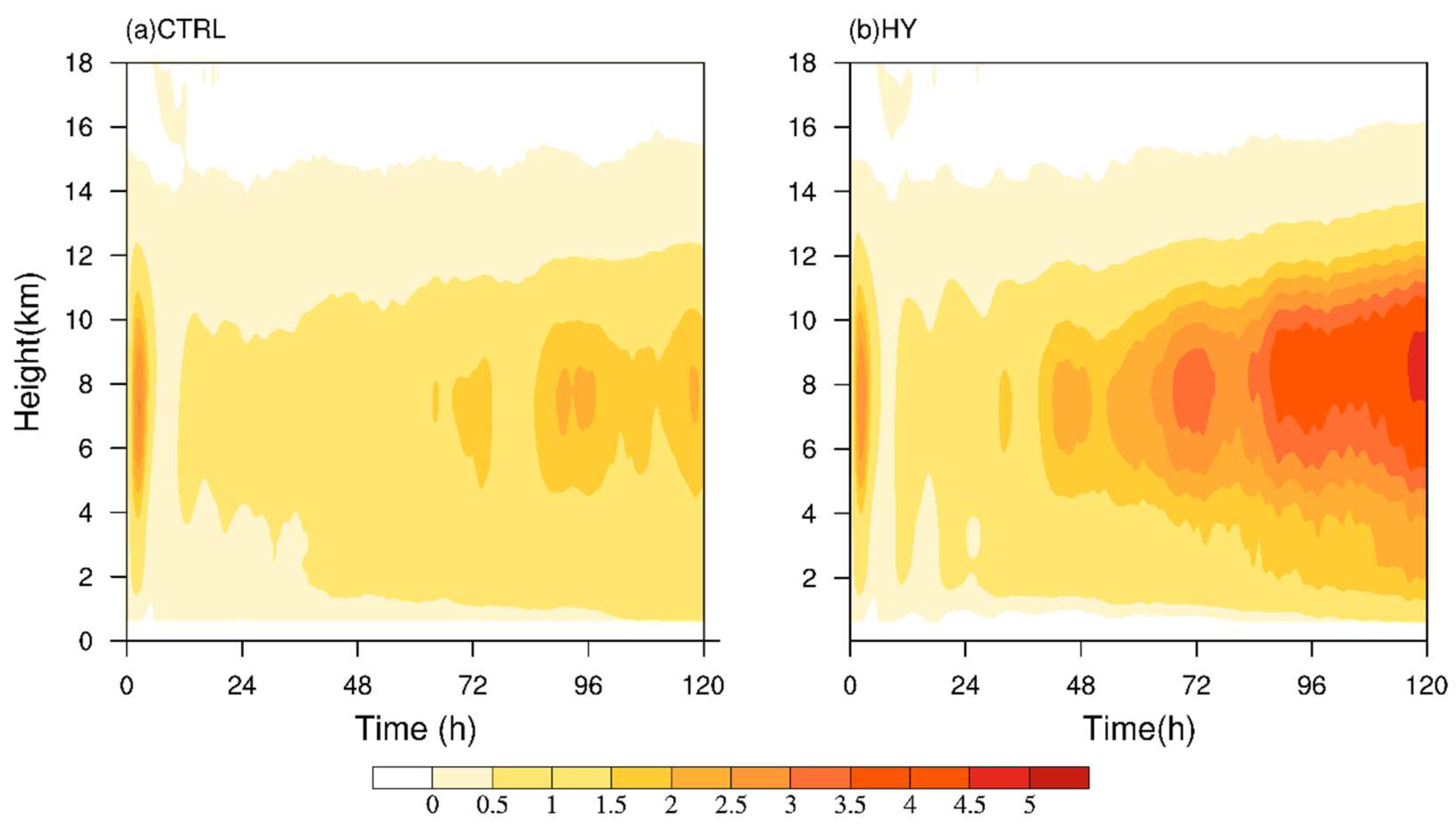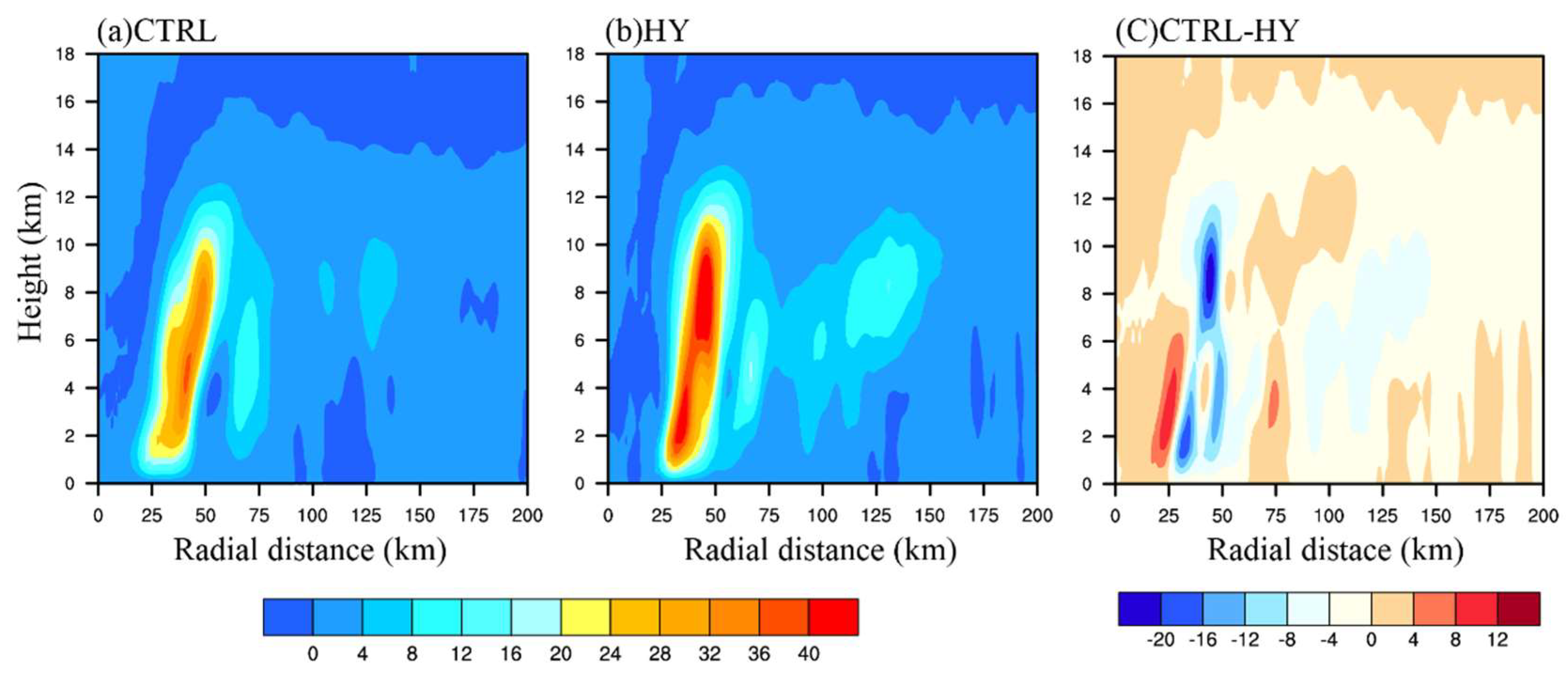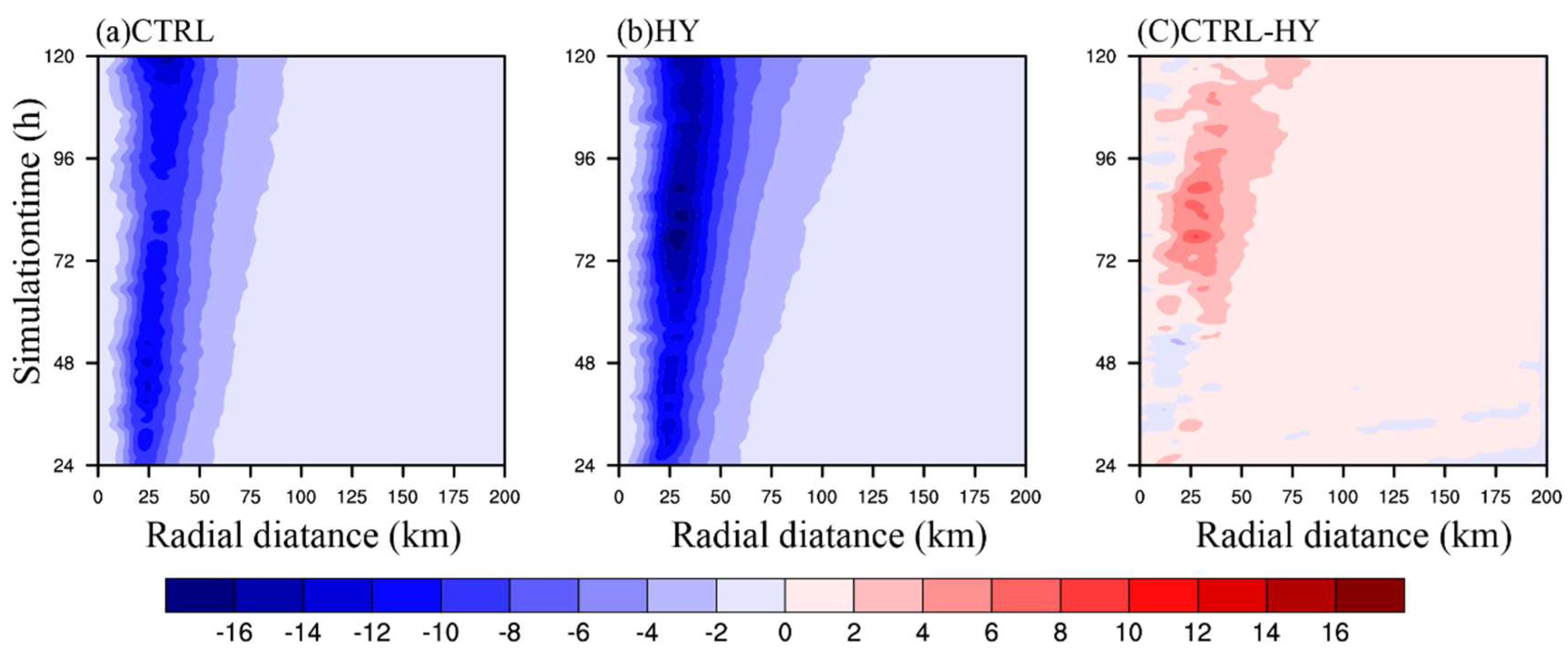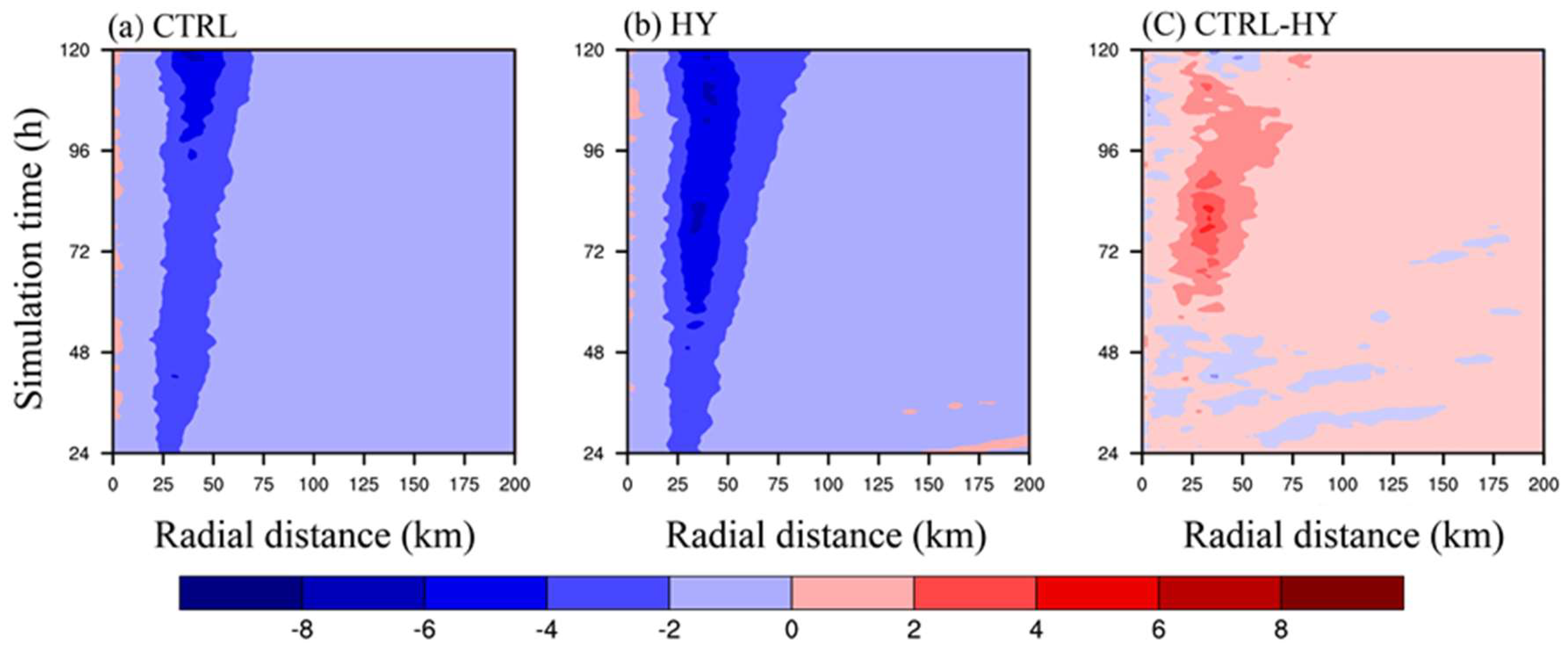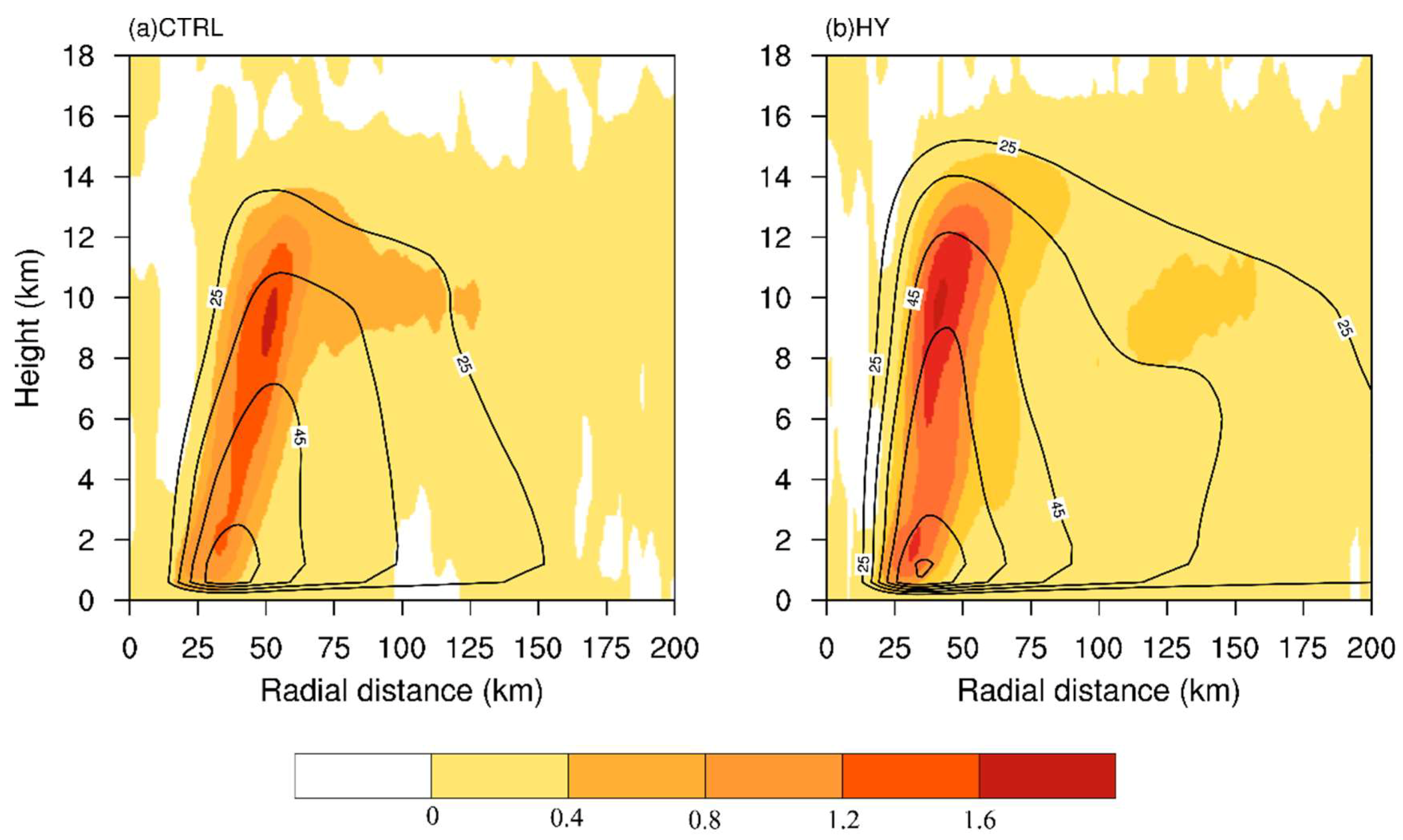3.1. Intensity and Size Evolution
As the storm originated in a quiescent environment on an
plane, it effectively remained stationary during the simulation (not shown).
Figure 1 shows the evolution of the storm intensity and size in terms of the minimum sea level pressure, the maximum azimuthal mean wind speed at the lowest model level (about 30 m altitude), and the radius of hurricane-force (33 m s
−1) wind for both runs. During the spin-up period, the storm intensifies rapidly and it expands steadily as the moist processes, low-level inflow, and upper-level outflow become progressively established (not shown). During the period from 18 h to 48 h, the difference in intensity between HY and CTRL tends to increase very gradually, i.e., although the storm in HY is stronger than in CTRL, the storm central pressure difference is <10 hPa and the difference in surface wind speed is <10 m s
−1. After about 48 h, the rate of intensification gradually slows, attaining a maximum surface wind speed of 55 m s
−1 and a minimum sea level pressure of 945 hPa at about 54 h. During the latter stage of the simulations, the TC intensities of the two simulations present substantial differences. After 84 h, both storms continue intensifying and their maximum sea level pressure deviation is as large as 36 hPa by the end of the runs.
Similar to the relationship of intensity, the expansion of storm size in CTRL is faster than in HY. The difference in storm size tends to increase gradually with time. Overall, the TC size in HY is much larger than in CTRL, i.e., by the end of the simulation, the expansion of the storm in HY is approximately 55 km (60%) greater compared with CTRL. The enlarged TC size in the HY simulation is associated primarily with the active outer rainbands. This indicates that the greater release of latent heat by the active rainbands in HY contributes to the larger TC size in HY relative to CTRL In the following sections, to elucidate the impact of nonhydrostatic processes on TC intensity and structure, the period between 84 and 96 h, which produced the greatest differences in TC intensity between the two runs, is considered for further analysis.
The azimuthal mean winds of CTRL and HY exhibit the typical structures of real TCs (
Figure 2), i.e., radial inflow in the boundary layer, radial outflow in the upper troposphere, a secondary outflow jet immediately above the inflow layer, and tangential winds with peak values within the inflow layer [
27,
28]. Some of the air mass at the top of the TC eyewall returns to the eye and it descends all the way to the lower levels through a narrow zone at the inner edge of the eyewall (
Figure 2a). Consistent with the relationship of intensity, the tangential winds are stronger in HY than in CTRL, and the eyewall in CTRL is tilted further outward in comparison with HY, as indicated by the updraft shown in
Figure 2. The TC in HY has a stronger and higher upward motion than in CTRL. The sloped vertical motion in CTRL exhibits a “wedge” shape, which is much thinner than in HY below the altitude of about 8 km. The maximum tangential wind appears in the inflow layer of the storm and reaches 75 m s
−1 at the radius of 30 km and the altitude of 1 km in HY. Conversely, the maximum tangential wind is only 65 m s
−1 in CTRL at the same position. The faster radial inflow in HY is linked to stronger convection in the eyewall. The intensity and structure of the modeled TCs are generally consistent with observations [
29], indicating that the following analysis based on the model output data is reliable.
Figure 3 displays the time evolution of the 10-m tangential winds in CTRL and the differences between CTRL and HY. The maximum tangential wind in CTRL is maintained at the radius of about 35 km in the mature stage (
Figure 3a). Their difference (
Figure 3b) indicates that the tangential wind field in the CTRL eyewall region is mostly weaker than in HY during the evolution of the intensity of the TCs. After 24 h, the 10-m tangential wind field in HY is significantly enhanced in the outer region. In the study of the maximum difference in TC intensity between 84 and 96 h, the 10-m tangential wind field in the eyewall region in CTRL is remarkably weaker than in HY (
Figure 3b), which is associated with the smaller low-level inflow in the boundary layer in CTRL (
Figure 2). This suggests that the influence of the hydrostatic assumption is significant in relation to TC intensity and that nonhydrostatic processes lead to weaker TC intensity.
Figure 4 shows snapshots of the simulated maximum radar reflectivity for CTRL and HY at 24-h time intervals. The quasiperiodic behavior of the rainbands leads to a variation in activity and fluctuation of the inner and outer rainbands [
30]. The inner and outer rainbands of the storm in CTRL are active throughout its lifetime. At the early stage (24 h), the inner rainbands around the eyewall in CTRL are thin and the outer rainbands are weak (not shown). With the further intensification of the storm (
Figure 1), the inner and outer rainbands develop steadily, i.e., the eyewall thickens and the rainbands become more widely distributed. As the convection of the rainbands strengthens, the size of the storm increases (
Figure 1c). Subsequently, the outer convective cells gradually move inward and merge, and the intensity of the TC increases rapidly (
Figure 1a). A complete convection ring forms on the outside of the inner eyewall, wrapped outside the original eyewall. In HY, the eyewall convection and inner rainbands are also active, but the characteristics of the outer rainbands exhibit agreat discrepancy relative to those in CTRL. Between 48 and 72 h, the spiral structure in HY is more pronounced than CTRL, which suggests that the outer rainbands are more active. At 96 h, the eyewall becomes much thicker than CTRL. The outer rainbands in HY throughout the simulation are consistently more active and cover a larger region than in CTRL (
Figure 4).
To better illustrate the difference of the vertical motion between CTRL and HY, the evolution of the vertical winds is shown in
Figure 5. In the eyewall with a radius of 30–60 km in the mid-troposphere (6 km), the convection in CTRL is strong, while the outer regions have weaker convection. However, when the hydrostatic dynamical core is used, the range of convection in the eyewall extends to the radius of 75 km. Convection in the eyewall show significant differences between CTRL and HY. At the inner side of the eyewall, the convection in HY is more active than in CTRL, while at the outer side of the eyewall (radius of approx. 50 km), the convection is stronger in CTRL than in HY. This might occur because the eyewall in CTRL is tilted further outward with height than in HY (
Figure 2a).
3.2. Vertical Momentum Budget
The vertical momentum budget is analyzed to elucidate the differences in the intensity and structure of the TCs between the CTRL and HY runs. In the WRF model, a reference state that is a function of height only is defined. To compute the vertical acceleration term in the vertical momentum equation, we first calculate the buoyancy and pressure perturbations based on this reference state. Perturbation quantities are derived by subtracting the reference-state value. The buoyancy force is not unique in the sense that it depends on the arbitrary choice of a reference density distribution; however, the sum of the buoyancy force and the perturbation pressure gradient is unique [
31].
The definition of the reference state is intended to separate the balanced state from any locally unbalanced disturbances. The conventional wisdom for isolated convection suggests that the hydrostatic balance dominates and that the reference state can be represented satisfactorily by the horizontally homogeneous clear air within a few hundred kilometers of the convection [
32]. TCs are rapidly rotating entities, and their convection, which is superimposed on a slowly evolving lateral circulation, is dominated by both the hydrostatic balance and the horizontal gradient wind balance. Therefore, the adoption of an appropriate method for defining the reference state is important. The reference state is defined by a running average using four neighboring points on constant σ surfaces [
21]. The low-wavenumber (0 and 1) storm structure was used here to define the reference state [
33], and a running Bartlett filter was applied to define the local reference state [
32].
In this study, the reference state was defined following Zhang et al. [
21]. First, a reference virtual temperature field (
) is obtained by performing a running average on the model output data using four neighboring points on constant
surfaces. Second, a reference pressure (
) is calculated by integrating the hydrostatic equation. The gas law (
, where
is the specific gas constant) is used to calculate a reference
. The reference-state variables are therefore functions of
. In this manner, the perturbation pressure, perturbation virtual temperature, and perturbation air density are given by
Because mature TCs are axisymmetric to a certain degree, we discuss the inner-core dynamics using cylindrical coordinates (
), where
r is the radius from the vortex’s minimum pressure pointing outward,
is the azimuthal angle, and
z is height. The vertical momentum equation is used to identify the causes of the difference in upward motion between the CTRL and HY runs, which can be written as follows [
21]
where
In the above, U, V, and W denote the radial, tangential, and vertical winds in cylindrical coordinates, respectively. The five terms on the right-hand side of Equation (5), which determine the quantity of vertical acceleration following a parcel, include the vertical perturbation pressure gradient force (denoted PGF), local buoyancy force (denoted LBF) containing the thermal and dynamic buoyancy relative to the surrounding environment, water loading (WL), Coriolis effects (WC), and diffusion effects (WD). The subsequent discussion treats the Coriolis and diffusion effects in combination (denoted as WCD).
Figure 6 displays the azimuthally averaged vertical acceleration of vertical wind for the CTRL and HY runs as well as their differences. The total vertical acceleration in both runs is positive at the middle and lower eyewall regions and the largest values appear at the height of approximately 1 km. The magnitude of the vertical acceleration in CTRL first decreases and then increases with height, and the sign changes at the level of the maximum upward wind. The maximum positive acceleration is consistent with the PGF, indicating that the PGF plays an important role in lifting convection in the eyewall (
Figure 7a). The LBF and WL are shown to both make major contributions to the formation of the negative peak vertical acceleration (
Figure 7). Outside the eyewall, the acceleration tends to decrease. It is worth noting that negative acceleration occurs down to the height of 3 km in the eye. At the inner edge of the eyewall, there is a region of large negative acceleration at 3–6 km, which indicates it might be advantageous to include the effects of the drag of hydrometeors in calculating the vertical acceleration.
The vertical acceleration in HY has a similar structure to that in CTRL. The maximum vertical wind occurs at the height of about 10 km in the eyewall. Below this level, the vertical acceleration is positive and there are two larger centers in the eyewall. There is also a region of large negative acceleration in the eyewall at 3–6 km. In this region, the drag effects in HY appear stronger than in CTRL, resulting in the decrease in vertical acceleration and the smaller vertical velocity. A region of negative acceleration exists above the level of approximately z = 10 km.
The differences between the two runs indicate that the value of vertical acceleration in the eyewall in HY is greater than in CTRL, except for the region at 3–6 km in the inner core. A budget analysis suggests that a stronger WL in HY than in CTRL is responsible for such a difference (
Figure 8). The results suggest that the greater involvement of clouds in this region contributes to enhanced effects of hydrometeor drag in HY. The combination of LBF and WL means the negative vertical acceleration in HY extends to a greater height than in CTRL. The vertical acceleration in the outer region in HY is generally slightly stronger than in CTRL, resulting in a strong updraft outside the eyewall.
Figure 7 depicts four budget terms in Equation (2). In CTRL, the largest term of PGF (
Figure 7a) is positive in the eyewall and the outer precipitation regions. However, it is negative in the eye down to 3 km. WL displays a similar structure but the opposite sign to PGF, with negative values in both the eyewall and the outer rainbands (
Figure 7c). Relative to PGF and WL, LBF and WCD are two smaller terms. Local buoyancy is dominated by positive buoyancy in the eye and negative buoyancy in the eyewall (
Figure 7b). The implication is that PGF tends to force relatively “colder” air to ascend in the eyewall and relatively “warmer” air to descend in the eye. The ascending parcels in the eyewall are therefore negatively buoyant [
21] (Zhang et al., 2000). Comparing PGF (
Figure 7a) with LBF (
Figure 7b) reveals that PGF has a significantly stronger effect than LBF on vertical acceleration. The PGF can completely offset the LBF and has a relatively large residual. The maximum value of PGF exceeds 20 (
) and is of the same order in WL, suggesting that WL also plays an important role in vertical acceleration (
Figure 7c). This result indicates that the effects of WL should be included in the eyewall when the hydrostatic balance is used to estimate the surface pressure of TCs. The WCD also contributes positively to the acceleration of vertical motion in the eyewall (
Figure 7d), as reported in Zhang et al. [
21].
Figure 8 displays the differences between the CTRL and HY runs for all the budget terms in Equation (2). The PGF in HY is negative in the eye (not shown). Below the melting level (near 5 km) in the eye and in the eyewall, positive differences indicate that the PGF (
Figure 8a), which plays a dominant role in lifting convection in the eyewall, is greater in CTRL than in HY. Above the melting layer, the PGF in HY is stronger than in CTRL, which results in the vertical winds reaching a greater height, i.e., approximately 15 km (
Figure 2b). The difference in LBF (
Figure 8b) shows the opposite characteristics to PGF. Below 3 km, LBF is negative in the eye. In the outer region, the differences between the two runs are also the opposite of the PGF. In HY, the larger LBF in the eyewall region corresponds to the stronger PGF, which suggests that the stronger vertical PGF imbalance will be offset by local buoyancy.
As stated above, the drag effects of WL cannot be ignored when calculating vertical acceleration. The difference of WL is presented in
Figure 8c, which shows that the differences between CTRL and HY in the eyewall and outer rainband regions at low levels are positive, suggesting that WL in the eyewall is notably stronger in HY than in CTRL. In HY, the weaker PGF at lower levels and the stronger effects of WL result in the stronger negative vertical acceleration at the height of 3–6 km in the eyewall region (
Figure 6b). The positive difference in the eyewall indicates that the drag effect in HY is more pronounced than in CTRL. Note, in the eyewall, the differences in both LBF and WL between CTRL and HY are positive (
Figure 8b), whereas they are negative for PGF above 5 km (
Figure 8a). This indicates that the imbalance induced by the more intense vertical PGF in the eyewall region is balanced by the stronger WL and LBF. The difference of WCD is shown in
Figure 8d. Below about 5 km in the eyewall, WCD is negative. The stronger WCD at low levels in HY contributes to the larger acceleration of vertical motion in that region (
Figure 6c). Above about 5 km, WCD is positive in the eyewall, which indicates that WCD is weaker in HY than in CTRL.
The above budget analysis indicates that the stronger vertical PGF is the most important factor in inducing the stronger vertical acceleration in HY, which leads to increased convective activity in the eyewall. This stronger convection causes both the low-level inflow and the high-level outflow to increase, which results in stronger tangential winds (
Figure 2b) and, consequently, a more intense storm. These results underscore the importance of the vertical imbalance generated by the vertical perturbation pressure force, local buoyancy, and water loading.
3.3. Tangential Wind Tendency Equation Budget
To further explain why the hydrostatic simulation develops a larger vertical motion than in the CTRL, we display in
Figure 9 the height–radius cross-sections of the equivalent potential temperature (
) and absolute angular momentum (AAM). The AAM in CTRL and HY decreases with height in the inflow layer, but increases with height in the outflow layer. The eyewall regions consist of densely inclined AAM contours, flattening in the upper outflow layer in both CTRL and HY. In the saturated eyewall, the AAM surfaces are almost parallel to the equivalent temperature
, indicating the existence of a conditionally symmetric neutral [
34]. In the TC environment, the potential instability is strong. The AMM is stronger in hydrostatic storm than in nonhydrostatic simulations, suggesting more potential instability, and the larger AAM is transmitted inward in the lower inflow layer, which promotes a larger tangential wind speed. In the lower inflow layer, the
both in HY and CTRL increases rapidly inward and reaches a maximum at the lower TC center. In the upper troposphere, the
rises sharply, the relatively low value appears in the middle and outer regions of the troposphere, and the low-value region is separated by the high-energy updraft that is transported upward by the boundary layer in the eyewall regions. The horizontal distribution of maximum CAPE in
Figure 10 indicates considerable CAPE in the storms’ environment, Consistent with the large potential instability in the ambiance of the hurricane. The higher-
air with more potential instability or convective available potential energy (CAPE) in the eyewall regions in HY indicates a stronger dynamic lifting resulting from the larger inflow in boundary layer.
The simulated TC has significant differences in convection both in the eyewall and the secondary circulation. The tangential wind is stronger in HY than CTRL, and a larger and stronger TC was formed. To analyze the differences in storm size and intensity between CTRL and HY, we diagnosed the tangential wind tendency equation, which can be written as [
35,
36]
where
f is the Coriolis parameter, and DISS is the surface friction and diffusion which is derived as a residual of Equation (7). The four terms on the right-hand side which determine the quantity of the azimuthally averaged tangential wind tendency (donated as TEN) include the horizontal advection (denoted as HADV), vertical advection (denoted as VADV), the eddy advection (denoted as eddy), and the surface friction and diffusion effects (DISS). The tangential wind tendency and all budget terms are compared in
Figure 11 and
Figure 12 for CTRL and HY. The HADV is shown as the only positive quantity in the boundary layer, indicating the inward transmission of absolute angular momentum that spins up the TC. Above the boundary layer, radial advection mainly contributes negatively to the tangential wind, while vertical advection produces a positive contribution. The contribution of the eddy processes is significant in the low-level eyewall regions. The surface friction mainly consumes the absolute angular momentum, but it also applies an inward force on the airflow [
4]. For CTRL, the increase of tangential winds in TC is most pronounced in the top outflow layer. The increase of tangential winds in the inner-core regions is relatively smaller than the outflow layer, which is related to a large negative HADV above the boundary layer. The increase of tangential wind in the outer regions is notable, which is mainly due to the non-adiabatic heating of the eyewall and the outer rainbands [
5]. Compared with CTRL, the increase of tangential winds in the eyewall and the outer rainband is slightly stronger in HY, and there is a similar structure in the tangential winds. In addition, in the eyewall and the 100-150 km radius regions, the tangential wind strengthening rate is significantly greater than CTRL, which indicates that the outer rainbands are more active in HY. The results indicate that the stronger non-adiabatic heating in the outer rainbands in HY result in a stronger increase of tangential winds, which contributes to a more intense and larger storm.
3.4. Explanation of the Hydrostatic Balance
Following on from the previous discussion, if we ignore the water loading, Coriolis force, and numerical diffusion, the vertical acceleration can be written as
Although the structure of the vertical acceleration in the eyewall is well organized in both HY and CTRL, the hydrostatic balance is satisfied approximately in the TCs (
Figure 13). A somewhat surprising feature is that when using the hydrostatic dynamic core, the hydrostatic balance is still not strictly met. The vertical acceleration in the eyewall is greater in HY than in CTRL (
Figure 7c). This is consistent with the results shown in (
Figure 13), whereby the vertical pressure gradient and gravity difference in the eyewall region is slightly larger in HY than in CTRL.
The horizontal distribution of vertical winds at different heights (
Figure 14) shows the largest difference between HY and CTRL. The outer rainbands are more active in HY, which is linked to the stronger vertical acceleration in HY at the outer region (
Figure 6c). At 3 km, there is significantly stronger convection in the eyewall in both CTRL (
Figure 14a) and HY (
Figure 14a). However, the convection in CTRL is always slightly stronger than in HY, which is consistent with the larger vertical acceleration at the lower levels of the eyewall in CTRL (
Figure 6c). At 6 km, a local ascending motion in the eyewall structure is stronger in CTRL than in HY; however, the eyewall is more contracted and more symmetrical in HY than in CTRL (
Figure 14b,f). On the 6-km height plane, the evolution of vertical winds over time (
Figure 5b) shows that the difference between CTRL and HY at the radius of 25–60 km has both positive and negative regions, and that the positive region is attributed to the shrinkage of the eyewall in HY. Moreover, at the outer region, the ascending motion is stronger and extends over a greater region in HY than in CTRL.
At 9 km, the characteristics in the eyewall are approximately the same as those at 6 km. Convection in the outer region in HY is significantly more active than in CTRL, which is because the positive vertical acceleration in HY at the outer region is significantly greater than in CTRL (
Figure 6c). At 15 km in CTRL, the eyewall structure disappears and upward motion is not evident (
Figure 14d). Conversely, in HY, the eyewall structure remains obvious and the vertical winds in the eyewall are significantly greater than in CTRL (
Figure 14h). These results show that convection at the eyewall region is stronger in HY than in CTRL and that the vertical winds in HY can reach a greater height, which is consistent with the larger vertical acceleration (
Figure 6b).
3.5. Dynamic Mechanisms and Thermal Mechanisms of TCs
To elucidate the processes associated with the contraction of the eyewall in HY, we consider the inherent dynamic and thermal mechanisms. Latent heat release, which is closely related to convection in the eyewall and the secondary circulation of the TC, is also a source of energy for maintaining and developing TC intensity.
Figure 15 depicts the time evolution of the azimuthal mean latent heat release. Latent heat release begins at the lifting condensing level. In CTRL, the latent heat release is small at the beginning of TC development, although it becomes larger after about 12 h. As the TC intensity increases, the release of latent heat becomes even larger at 72 h, and it is especially pronounced at the height of 5–10 km (
Figure 15a). The structure of latent heat in HY is similar to CTRL. The main difference is that the magnitude of the release of latent heat in HY is notably greater than in CTRL, which results in enhanced TC intensity starting from approximately 48 h (
Figure 1).
Figure 16 exhibits height–radius cross-sections of the azimuthal mean latent release in the two runs as well as their difference. The latent heat release in both CTRL and HY is pronounced in the eyewall and the maximum is concentrated at the height of about 8 km (
Figure 16a,b). The structure of the latent heat release is consistent with the structure of the distributions of the vertical and horizontal wind vectors (
Figure 2). The location of latent heat release closer to the center of a TC is more conducive to the reduction of the central pressure [
37]. In the previous sections, we discussed the inward contraction of the eyewall in HY. Our results indicate that the latent heat release in the eyewall is stronger and closer to the TC center in HY than in CTRL (
Figure 16c), which contributes to the reduction of the central pressure and leads to the significantly greater TC intensity in HY than in CTRL (
Figure 1). Because of this, the pressure gradient force will increase, which will then change the net radial force.
Figure 17 displays the time evolution of the radial pressure gradient in the CTRL and HY runs as well as their differences. The pressure gradient for both runs is most significant near the eyewall region, where the convection is most active and the pressure deepens inward rapidly [
38]. The outer rainbands, which are more active in HY than in CTRL, cause a larger pressure gradient radial range. From the difference between the two runs, it can be seen that the pressure gradient in HY is significantly larger than in CTRL in the eyewall region from about 48 h to the end of the simulation. This might be attributable to an increase in the release of latent heat in the eyewall region (
Figure 16), which results in reduced central pressure and further increases the pressure gradient.
The net radial force, which is defined to evaluate the degree of gradient wind imbalance, can be written as follows [
39]:
Hovmöller diagrams of the net radial force for CTRL and HY as well as their differences are presented in
Figure 18. The net radial force for both runs is significant in the eyewall region, but with stronger values in HY. The gradient wind imbalance in the eyewall region is significant. The negative radial force corresponding to the subgradient wind indicates a tendency to accelerate the inflow. The maximum net radial force in HY is 50% larger than in CTRL (
Figure 18c), which should be attributable to the larger pressure gradient in HY (
Figure 17c). This result indicates that the greater net radial force in HY causes the eyewall to contract inward, allowing latent heat release closer to the center of the TC. The greater release of latent heat (
Figure 16b) is conducive to TC strengthening (
Figure 1), which further leads to an increase of the radial pressure gradient of the eyewall (
Figure 17). Such positive feedback causes the eyewall to contract, which leads to greater convective activity in the eyewall. In fact, as the pressure gradient increases, the tangential winds in HY will increase (
Figure 2) to maintain the gradient wind balance [
40].
To clarify the relationship between eyewall contraction and TC intensity, we present height–radius cross-sections of the azimuthal mean vertical winds and tangential winds in
Figure 19. The eyewall in CTRL slopes outward with height, whereas the eyewall in HY shrinks inward in comparison with CTRL (
Figure 19). Moreover, the tangential winds have a greater vertical extent in HY than in CTRL. The less slanted contours reflect the larger radial and tangential wind gradients, which are beneficial to increased TC intensity [
41]. This suggests that the greater vertical wind of the eyewall in HY is related to the contraction of the eyewall and the more vertical tangential wind contours (
Figure 19b). Meanwhile, the larger vertical motion leads to greater convective activity in the eyewall, which contributes to TC intensification.
